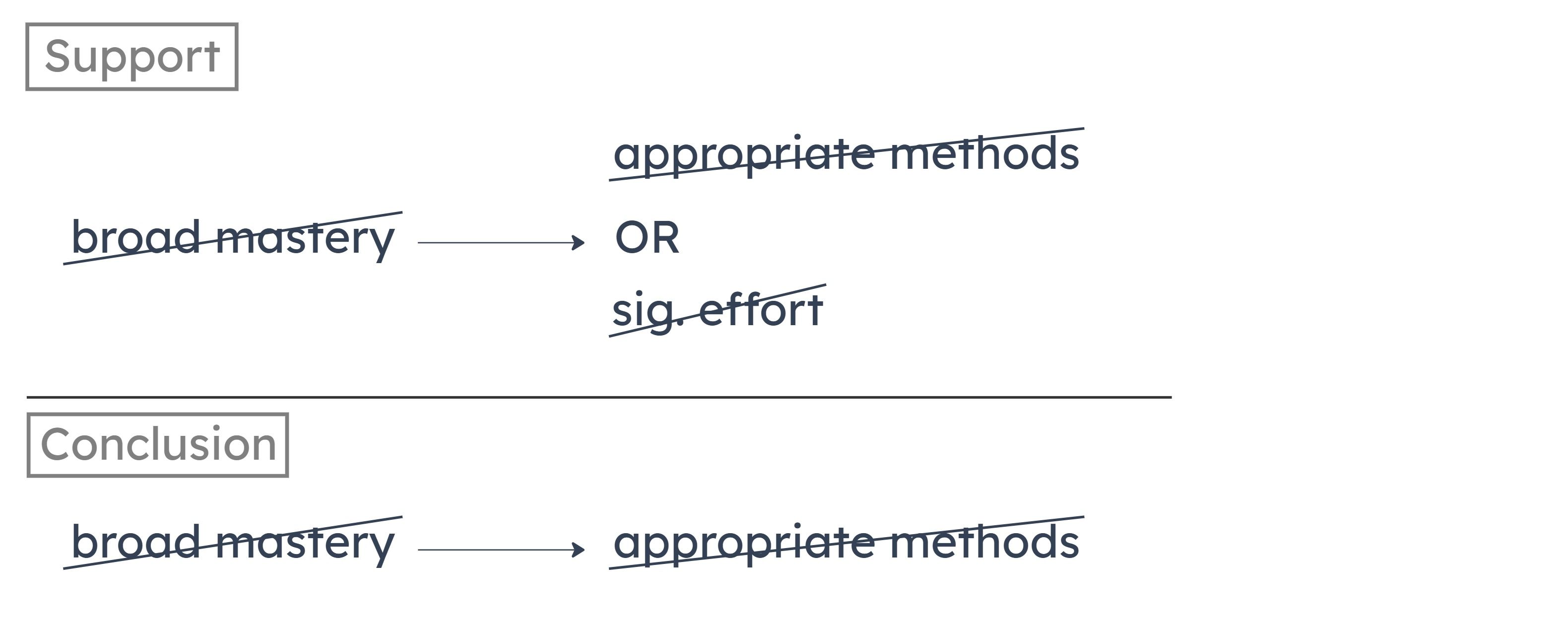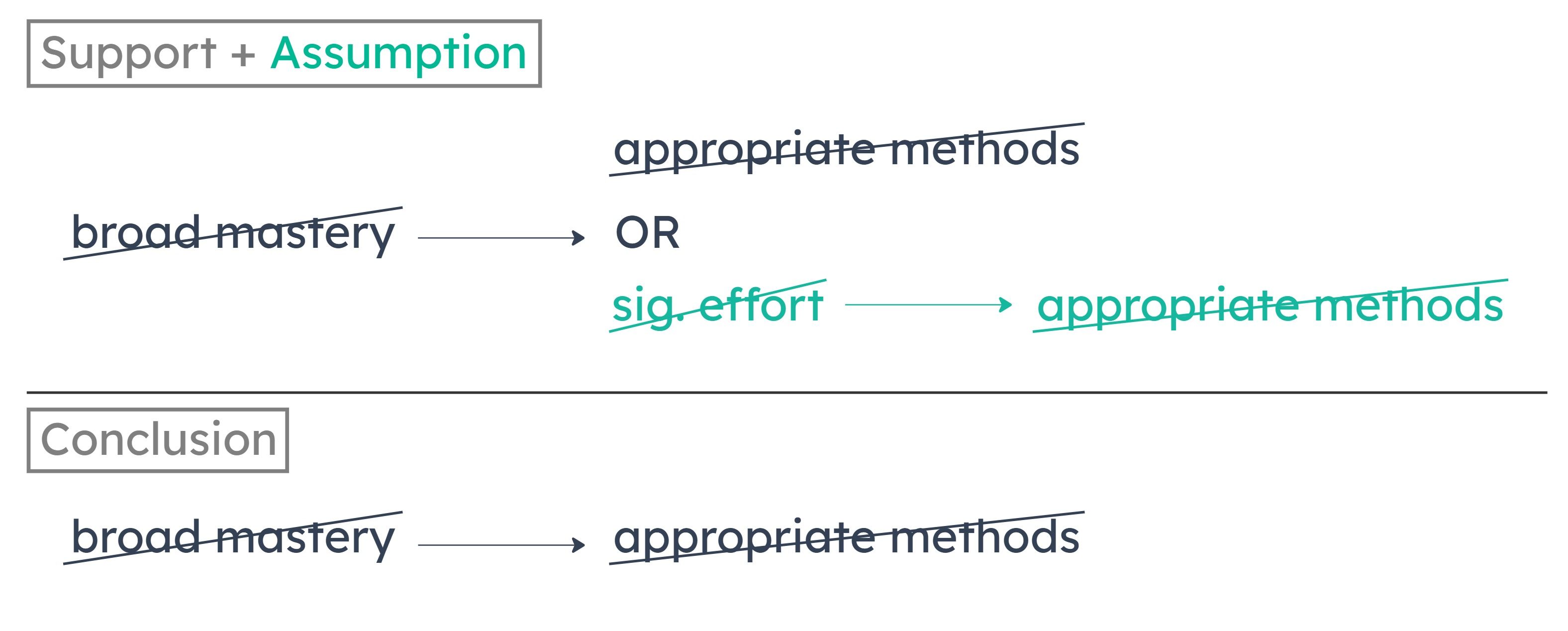Sign up to star your favorites LSAT 140 - Section 3 - Question 17
January 19, 2014Science teacher: In any nation, a flourishing national scientific community is essential to a successful economy. For such a community to flourish requires that many young people become excited enough about science that they resolve to become professional scientists. Good communication between scientists and the public is necessary to spark that excitement.
Summary
If a nation has a successful economy, it must have a flourishing national scientific community. If the nation has a flourishing national community, it needs to have many young people who are excited enough about science to want to become scientists. If this excitement exists, there must be good communication between scientists and the public.
Strongly Supported Conclusions
Successful economy -> flourishing scientific community -> young people excited - > good communication between scientists and the public.
You can make any valid inference along this chain.
A
If scientists communicate with the public, many young people will become excited enough about science to resolve to become professional scientists.
Scientists communicating with the public is not a sufficient condition that can trigger any valid inferences. If you got this wrong, practice conditional indicators, mapping, and following lawgic chains.
B
The extent to which a national scientific community flourishes depends principally on the number of young people who become excited enough about science to resolve to become professional scientists.
While young people's excitement about science is necessary for a national scientific community to flourish, there is no evidence that *the number* of these students is principally important.
C
No nation can have a successful economy unless at some point scientists have communicated well with the public.
This is supported because it is a valid inference on the formal logic chain (Successful economy -> good communication). If you struggled to map this, practice mapping with two conditional indicators.
D
It is essential to any nation’s economy that most of the young people in that nation who are excited about science become professional scientists.
This is too strong to support. The stimulus only says that many young people need to be excited about science, not “most.”
E
An essential component of success in any scientific endeavor is good communication between the scientists involved in that endeavor and the public.
This is not supported because the stimulus never gives conditions for the success of any scientific endeavor.
Sign up to star your favorites LSAT 140 - Section 3 - Question 16
January 19, 2014
A
Reproduction in predator populations increases when sunspot activity indirectly affects hormonal processes associated with reproduction.
B
Local weather patterns that can affect species’ population changes can occur both in the presence of sunspot activity and in its absence.
C
Brighter light during sunspot activity subtly but significantly improves the ability of predators to detect and capture hares.
D
The variation from cycle to cycle in the magnitude of the highs and lows in snowshoe hare populations is highly correlated with variations from cycle to cycle in the intensity of highs and lows in sunspot activity.
E
Sunspot activity is correlated with increases and decreases in the nutritional value of vegetation eaten by the hares.
Sign up to star your favorites LSAT 140 - Section 3 - Question 15
January 19, 2014Sign up to star your favorites LSAT 140 - Section 3 - Question 13
January 19, 2014
A string of numbers might be easier to remember if they are part of a song.
A
There are some things that children cannot learn without the aid of songs.
B
Familiarity with a concept is not always sufficient for knowing the words used to express it.
C
Mnemonic devices such as songs are better than any other method for memorizing numbers.
D
Children can learn to count without understanding the meaning of numbers.
E
Songs are useful in helping children remember the order in which familiar words occur.
Sign up to star your favorites LSAT 140 - Section 3 - Question 12
January 19, 2014
A
The heavier of two cans of fruit or vegetables does not necessarily contain more food than the lighter of the two cans contains.
B
The weight of the water in a can of fruit or vegetables can be more than half the total weight of the can’s contents.
C
Nothing stops unscrupulous canning companies from including more water per can than others include.
D
Some canning companies include less food in cans of a given weight than others include.
E
The heavier of two cans of fruits or vegetables may include more water than the lighter of the two cans contains.
Sign up to star your favorites LSAT 140 - Section 3 - Question 11
January 19, 2014
The conclusion would follow if we assumed that when there’s a lack of significant effort, there must also be a lack of appropriate methods. In that case, no matter what, a lack of broad mastery always means a lack of appropriate methods.
A
As long as secondary school students are taught with methods appropriate to their learning styles, they will devote significant effort to their studies.

B
Even if secondary school students are taught with methods appropriate to their learning styles, they will not achieve broad mastery of the curriculum if they do not devote significant effort to their studies.
C
Secondary school students do not achieve broad mastery of the curriculum if they are not taught with methods appropriate to their learning styles.
D
Teaching secondary school students with methods appropriate to their learning styles does not always result in broad mastery of the curriculum by those students.
E
Secondary school students who devote significant effort to their studies do not always achieve broad mastery of the curriculum.
Sign up to star your favorites LSAT 140 - Section 3 - Question 10
January 19, 2014Company president: Whenever you subcontract the manufacturing of a product, you lose some control over the quality of that product. We do subcontract some manufacturing, but only with companies that maintain complete control over the quality of the products they supply.
Summary
Company president:
Subcontracting manufacturing means losing some control over product quality.
We do subcontract some manufacturing.
We only subcontract with companies that have complete control over the quality of their products.
Very Strongly Supported Conclusions
The president’s company loses some control over its product quality.
The company’s subcontractors do not lose any control over their product quality.
The company’s subcontractors do not subcontract their manufacturing.
A
When the president’s company subcontracts manufacturing of a product, it does not allow the subcontractor to further subcontract manufacturing of that product.
Very strongly supported. Subcontracting manufacturing means losing some control over product quality. But the company’s subcontractors “maintain complete control over the quality of the products they supply.” So the subcontractors must not further subcontract their manufacturing.
B
Companies that subcontract the manufacturing of products are often disappointed in the quality of those products.
Unsupported. Subcontracting manufacturing reduces control over product quality, but it doesn't necessarily mean lower quality. It also doesn’t mean that companies will be disappointed with the quality of products that have been manufactured by a subcontractor.
C
The company president insists on having as much control as possible over the quality of the company’s products.
Anti-supported. Subcontracting manufacturing means losing some control over product quality. Since the company president subcontracts some manufacturing, he likely doesn’t insist on having as much control as possible over product quality.
D
When consumers know that a product has been manufactured by a subcontractor, they are generally dubious about the product’s quality.
Unsupported. Subcontracting manufacturing reduces control over product quality, but it doesn't necessarily mean lower quality. It also doesn’t mean that customers will question the quality of a product that has been manufactured by a subcontractor.
E
When a company manufactures some products in-house and subcontracts the manufacturing of others, the products made in-house will be of uniformly better quality.
Unsupported. Subcontracting manufacturing reduces control over product quality, but it doesn't necessarily mean lower quality. Just because a product is made in-house doesn’t ensure that it will be of better quality.
Sign up to star your favorites LSAT 140 - Section 3 - Question 09
January 19, 2014Sign up to star your favorites LSAT 140 - Section 3 - Question 01
January 19, 2014
Here, the ad assumes that banking at TekBank costs more just because ATM use at TekBank costs more. However, other factors, like getting a loan or opening an account, might actually make TekBank cheaper than GreenBank.
A
bases a recommendation solely on economic factors without considering whether other factors are more important
B
presents claims that are irrelevant to the issue under discussion in order to divert attention away from that issue
C
draws a conclusion about the overall cost of a service solely on the basis of a claim about the cost of one component of that service
D
concludes that a component of a service must have a property that the service as a whole possesses
E
concludes that a claim must be false because of the mere absence of evidence in its favor
Sign up to star your favorites LSAT 140 - Section 3 - Question 08
January 19, 2014